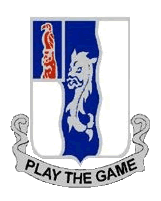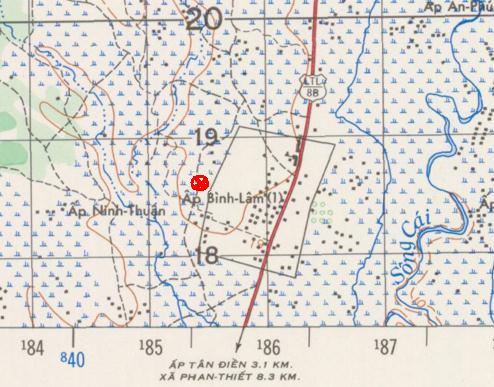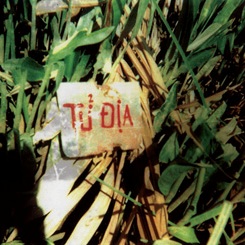GIs...."STAY OUT!"
Copyright 2006: Darwin Stamper. All rights
reserved. (copy permission at bottom)
Webmaster's Introduction: Darwin "Scotty" Stamper was an experienced Non Commissioned Officer with more than one tour in Vietnam to his credit. This story is a good example of how valuable experienced "NCOs" were to the war effort. Also....View Scotty's comments to the "DISCERNING THE TIGER" story here on the War Stories pages. |

| During my first tour in Vietnam in 1966 to 1967, I was with the 1st
Infantry Division (Big Red One) and my unit’s normal duties at one point included
ambushing Viet Cong (VC) sampans at night along the Song Be River. During the day there
was no rest for the weary and we conducted patrols of the same area. The river was heavily
populated and there was heavy VC activity all throughout the river’s vicinity. One
day we came upon something that really shocked me. It was a bamboo thicket with hand
written signs along the perimeter of the thicket that said “GIs stay out”,
“Mines” or “booby traps stay out!” As I peered into the thicket, I
could see mortar rounds and grenades hanging from the trees and on the ground were
artillery and mortar rounds set up as booby traps. (What would today be call Improvised
Explosive Device or “IEDs”). We wondered what was inside this thicket that the
VC didn’t want us to see? A base camp, hospital, or arms cache maybe? Fortunately our platoon leader had enough common
sense to back off. A few months later we came across another
bamboo thicket with the same kinds of signs and the same booby trapped ordinance.
Unfortunately, our Commanding Officer (CO) decided that we should move into the thicket
and check it out. That cost us two dead and
four wounded when the CO´s RTO tripped a booby trap. We repaired
the track and continued on with our patrol, but I noticed the LT never again hung his foot
over side of his APC! I didn’t
have long to wait as the LT came up and asked me what I was doing. I told him that I
pulled the troops out before someone got killed or maimed. I told him that I had been
through this before and I didn’t want to get my people killed when they couldn’t
fight back. He told me that I had probably just gotten him relieved of duty. I replied
that It had been “my call” and would take full responsibility. |
Webmaster's Addendum, Summer of 2006: Subsequent to the posting of this account on the website, Bob Camors, former Commanding Officer of both "Alpha" and then "Bravo" Companies provided information on this Bamboo forest. It was referred to as "Stitt's Woods" after the Forward Air Controller who was called & sent in F-4's to blast the place in September of 1969. Following is a section of Map Sheet 6631-III, showing the approximate location of the site at coordinates AN854186 |
|
Webmaster's Addendum, Fall of 2006: More recollections have come in on Scott Stamper's "Stitt's Woods" story. Mike Chisam, former 1st Platoon Leader, "Bravo" Company, sent along these reflections on his experiences in the area. |
Stitt’s Woods!! I know it well! I would have guessed it was about 400 meters west of the "X"
on Bob Camor's Map (above), but … I don’t have my maps and it has been 37
years!! Bob is probably right on!! (Editor’s note: In determining the
“Stitt’s Woods” location, Bob Camors was very adamant about this location. He STILL has his maps!! And I believe his
recollection is very accurate.)
|
Webmaster's Addendum, Summer of 2017: More recollections have come in on Scott Stamper's "Stitt's Woods" story. Bob Camors sent a detailed description of several events involving "Stitt's Woods. |
|
This was around October 1969 (Likely the 14th) at LZ Betty.
I was the Assistant S-3 of the 1st Bn.
50th Infantry. As I remember that
day, I was in a helicopter flying from our Battalion Headquarters to
the district town of Thien Giao where we had a small forward
operational base to do some routine business and I was listening to
the battalion radio net. The day was hot and clear. A call
came in from A Company that one of its platoons had gotten into a
booby-trapped area and was taking casualties. It turned out that
SFC Anthriest Hill was the platoon sergeant of that platoon. The
area was just to the west of a small village and was separated from
the village by rice paddies. The enemy had some kind of
underground base in the area – the area was probably less than 400
meters by 600 meters surrounded by rice paddies on all sides.
The platoon had been operating in the area and had taken sniper fire
from the area before. I can’t remember if they went in there on
some kind of planned operation or it was a response to enemy fire.
The area was wooded with these short, stunted, gnarled trees that were
not more than 12 feet tall with tangled branches that you would have
to stoop down to see under. The ground was hard-pan with a light
scattering of leaves. There were a few trails through he area
but, of course, the trails were where most of the booby-traps and
mines were so you wanted to avoid the trails but if you got off the
trail, you had to squat down and sort of stoop over or duck-walk to go
anywhere. The kind of booby-traps they were encountering were hand grenades
rigged with tripwires or mines which would explode if you hit
a tripwire or stepped on them. At that time, I did not know SFC Hill. Before long, the company commander, Captain David Parker as I remember, went in to try to help and was quickly wounded in the face by the explosion of a booby-trap. The situation was degenerating because the platoon had gotten inside this wooded area and there were booby-traps everywhere and they were not sure they could find a way out without encountering more. Also, by that time, I think at least one had been killed and many more wounded - about 1/3 of the platoon were down as casualties. That means that every soldier had to carry or help another wounded soldier. They were almost unable to defend themselves plus they continued hitting booby-traps causing more casualties. I remember there being one or two KIA and as many as 6 other WIA out of a 20 man platoon (approximately). Some of the wounded urgently needed evacuation to medical care.
Either the helicopter pilot or I spotted a little cleared area
inside the woods not too far from the platoon that a single helicopter
could barely set down in... and the helicopter aircraft commander was
willing to try it. The plan was to get the platoon to move
across (it was not far) to the open area and take them out in several
loads in the helicopter, taking the most seriously wounded first.
As I recall it, by that time SFC Hill was in charge of the platoon
because if there was an officer present, he had been wounded and the
company commander was not able to do much due to wounds,
as I remember it. I was in the helicopter when it first landed
(safely – we were worried about the open area being mined also) and we
took out the wounded. I remember seeing SFC Hill on the ground
organizing the “chalks” (groups of soldiers which would load the
helicopter). He was calmly doing all that needed to be done and
keeping them from moving around too much so there would not be another
explosion. He was also talking to me on the radio and working
out the plan..
I flew back with the chopper and off loaded and I don’t think I
went back because that would reduce the maximum number they could take
out. After everyone was out, the company commander was
Med-evac’d to Japan. After that day, our battalion commander, LTC
Gilbert, got the Air Force Forward Air Controller, Captain Earl Stitt,
to call in many airstrikes with 500 pound bombs on that area.
When you flew over, it was filled with bomb craters. We called
it “Stitt Woods” from then on.
I was sent in to take command of Company A, for about 2 months while the company commander recovered (at
first we did not know if he would be back or not). I went to the
Fire Support Base Sandy where the company was and took command.
SFC Hill was the platoon leader. I wrote up a recommendation for
a Bronze Star for Valor award because of his courageous and calm
actions on that day which I personally observed. He was, of
course, in danger like everyone else, and the safe thing to do would
have been to sit still and move as little as possible. Without
regard to his personal safety, he moved around, encouraging, helping
others, planning how to get out of that mess. I think he saved
some lives that day. If he had not gotten them to the
helicopter, some of those wounded would not have made it. My
time with A Company was short – only two months. During that
time, I saw that SFC Hill seemed to focus a lot of attention on the
more “lost souls” among our soldiers, trying to keep them away from
drugs and to deal with their other problems. I left to take over
B Company when CPT Parker came back from Japan. Several months
later, I checked on the Bronze Star award and found out that the first
sergeant of the company had not sent in the award recommendation that
I had written and I had it re-submitted. I believe it was
because SFC Hill is African American and the first sergeant was a
bigot. As I said before, SFC Hill was a deeply good man and a
good soldier. I respected him very much and tried to get him to
extend his tour but he said he could not and during the rest of my
Army career we were never in touch. I have re-connected with SGM
Hill and I am very happy to learn that he went home to a warm and
loving family. As the rest of my tour went on, I wished he was
still there and missed his calm and through leadership. He is
someone who made a real difference in this world. Those were
difficult times to be a soldier.
|
Webmaster's Addendum, February of 2010: Reference the book "Enter and Die" by James W. Milliken. The book is a memoir of the author who served with "D" Company, 2nd Battalion, 60th Infantry in the 9th Infantry Division in 1968-69. These mined areas were quite prolific throughout the delta region in which he served. It was common practice to avoid these areas at all cost. They were set up by the enemy who knew American "curiosity" would draw them in and inflict casualties. Pictured below is a sign common to these areas in the delta. I could find no Vietnamese translation for the term "Tu Dia". It is my "hunch" that the sign maker did not speak English...but had learned the phrase "To Die"...and tried to translate this using Vietnamese characters. "Tu" is pronounced "to" and is the Vietnamese pronoun for "you" (Familiar) and "Dia", in Vietnamese is pronounce "Die". Hence a "Loosely" translated "To Die".
My translation in the previous paragraph, based on a "hunch" is
somewhat in error. In 2014, I read the book "Silence Was A Weapon, The
Vietnam War in the Villages" by Stuart A. Herrington. In his research
into a village in Southwestern South Vietnam (Tan My), the author,
fluent in Vietnamese,
spent months developing a relationship with a former Vietcong leader
who explained:
|
| (1) From the Book "Street Without Joy" by Bernard B. Fall, First Published in 1961, ISBN: 0805203303 |

Copyright 2002 Darwin S. Stamper,
Contact via Webmaster: Website Committee
Permission is hereby granted to copy this
story to print or
on web pages at no charge provided the line below is included:
Reprinted from the 1st Bn (Mech) 50th Infantry website http://www.ichiban1.org/
( web sites should make the url a link or may also just link to this page )

